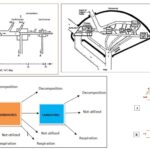what is krebs cycle
what is krebs cycle
Please login to submit an answer.
The Krebs cycle, also known as the citric acid cycle or tricarboxylic acid (TCA) cycle, is a central biochemical pathway within aerobic respiration. It involves the enzymatic oxidation of acetyl-CoA to produce carbon dioxide, high-energy electron carriers (NADH and FADH₂), and a small amount of GTP (or ATP). Discovered by Sir Hans Adolf Krebs in 1937, this cycle operates in the mitochondrial matrix in eukaryotes and the cytoplasm in prokaryotes. It consists of a series of eight enzymatic reactions that not only generate energy equivalents but also provide biosynthetic intermediates for amino acids, fatty acids, and nucleotide synthesis. The Krebs cycle is a key metabolic hub, integrating catabolic and anabolic pathways and regulating cellular energy metabolism.
- Share on Facebook
- Share on Twitter
- Share on LinkedIn
Helpful: 0%




